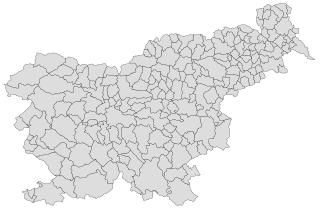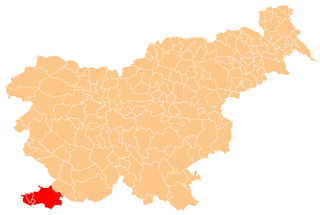
Istria is the largest peninsula within the Adriatic Sea. The peninsula is located at the head of the Adriatic between the Gulf of Trieste and the Kvarner Gulf. It is shared by three countries: Croatia, Slovenia, and Italy, with 90% of surface area being part of Croatia. Croatia encapsulates most of the Istrian peninsula within Istria County.

Koper is the fifth largest city in Slovenia. Located in the Istrian region in the southwestern part of the country, approximately five kilometres south of the border with Italy and 20 kilometres from Trieste, Koper is the largest coastal city in the country. It is bordered by the satellite towns of Izola and Ankaran. With a unique ecology and biodiversity, it is considered an important natural resource. The city's Port of Koper is Slovenia's only container port and a major contributor to the economy of the Municipality of Koper. The influence of the Port of Koper on tourism was one of the factors in Ankaran deciding to leave the municipality in a referendum in 2011 to establish its own municipality. The city is a destination for a number of Mediterranean cruising lines. Koper is the main urban centre of the Slovenian Istria, with a population of about 25,000. Aleš Bržan is the current mayor, serving since 2018.

Piran is a town in southwestern Slovenia on the Gulf of Piran on the Adriatic Sea. It is one of the three major towns of Slovenian Istria. The town is known for its medieval architecture, with narrow streets and compact houses. Piran is the administrative seat of the Municipality of Piran and one of Slovenia's major tourist attractions. Until the mid-20th century, Italian was the dominant language, but it was replaced by Slovene following the Istrian exodus.

Slovenia is divided into 212 municipalities, of which 12 have urban (metropolitan) status. Municipalities are further divided into local communities and districts.

Radiotelevizija Slovenija – usually abbreviated to RTV Slovenija – is Slovenia's national public broadcasting organization.

Rai 3 is an Italian free-to-air television channel owned and operated by state-owned public broadcaster RAI – Radiotelevisione italiana. It was launched on 15 December 1979 and its programming is centred towards cultural and regional programming. It has always been considered the most left-leaning channel of Italian public television; its direct competitor to Mediaset's Rete 4.
Slovenia participated in the Eurovision Song Contest 2005 with the song "Stop" written by Omar Naber and Urša Vlašič. The song was performed by Omar Naber. Slovenian broadcaster Radiotelevizija Slovenija organised the national final EMA 2005 in order to select the Slovenian entry for the 2005 contest in Kyiv, Ukraine. Fourteen entries competed in the national final where the winner was selected over two rounds of public televoting. In the first round, the top three entries were selected. In the second round, "Stop" performed by Omar Naber was selected as the winner.

Slovenia has been a meeting area of the Slavic, Germanic, Romance, and Uralic linguistic and cultural regions, which makes it one of the most complex meeting point of languages in Europe. The official and national language of Slovenia is Slovene, which is spoken by a large majority of the population. It is also known, in English, as Slovenian. Two minority languages, namely Hungarian and Italian, are recognised as co-official languages and accordingly protected in their residential municipalities. Other significant languages are Croatian and its variants and Serbian, spoken by most immigrants from other countries of former Yugoslavia and their descendants. Slovenia is ranked among the top European countries regarding the knowledge of foreign languages. The most often taught foreign languages are English and German, followed by Italian, French, and Spanish.
Slovenia participated in the Eurovision Song Contest 1999 with the song "For a Thousand Years" written by Sašo Fajon and Primož Peterca. The song was performed by Darja Švajger, who had previously represented Slovenia in the Eurovision Song Contest in 1995 where she placed seventh with the song "Prisluhni mi". Slovenian broadcaster Radiotelevizija Slovenija organised the national final EMA 1999 in order to select the Slovenian entry for the 1999 contest in Jerusalem, Israel. 17 entries competed in the national final where "Se tisoc let" performed by Darja Švajger was selected as the winner following the combination of votes from a four-member jury panel and a public televote. The song was later translated from Slovene to English for the Eurovision Song Contest and was titled "For a Thousand Years".

The Italian language is an officially recognized minority language in Slovenia, along with Hungarian. Around 3,700 Slovenian citizens speak Italian as their mother tongue, mostly Istrian Italians. Italian has a strong presence in Slovenia, both historical and current. An estimated 15% of Slovenians speak Italian as a second language, which is one of the highest percentages in the European Union.

Gravisi–Barbabianca Mansion is a Baroque mansion in Koper, a port town in southwestern Slovenia. It was built in 1710. It was the family seat of the Gravisi family, who held the title of the Marquis of Pietrapelosa. Today it is the home of a music school.

Istrian Italians are an ethnic group from the Adriatic region of Istria in modern northwestern Croatia and southwestern Slovenia. Istrian Italians descend from the original Latinized population of Roman Histria, from the Venetian-speaking settlers who colonized the region during the time of the Republic of Venice, and from the local Croatian people who culturally assimilated.

Slovene Istria is a region in southwest Slovenia. It comprises the northern part of the Istrian peninsula, and it is part of the wider geographical-historical region known as the Slovene Littoral. Its largest urban center is Koper. Other large settlements are Izola, Piran, and Portorož. The entire region has around 120 settlements. In its coastal area, both Slovene and Italian are official languages.

The Koper Regional Museum has been housed since 1954 in the spacious early 17th century Belgramoni Tacco Palace, and is responsible for the movable cultural heritage in Primorska region of Slovenia. The museum originated in 1911 as the Municipal Museum of History and Art. At its centenary in 2011, the museum opened a new permanent exhibition Between the Serenissima, Napoleon and the Habsburgs and enriched its collection.

The Slovene Riviera is the coastline of Slovenia, located on the Gulf of Trieste, by the Adriatic Sea. It is part of the Istrian peninsula and is 46.6 km long. The region comprises the towns of Koper and Piran with Portorož, and the municipality of Izola. It is a seaside tourist destination, with a vibrant multiethnic Slovenian and Italian heritage.
Radio Koper / Radio Capodistria is a radio station located in the city of Koper, Slovenia. It can be heard from Slovenia and northeastern part of Italy on the main frequency of FM 103.1 MHz in Italian and 88.6 MHz in Slovene. Good reception is possible on medium wave AM 1170 kHz in Slovenia, Croatia and North Italy. It is also available on the Satellite through Eutelsat 16A a 16°Est. Radio-Television Slovenia is the owner of the Radio.
Slovenia participated in the Eurovision Song Contest 2016 with the song "Blue and Red" written by Marjan Hvala, Manuella Brečko and Leon Oblak. The song was performed by ManuElla, which is the artistic name of singer Manuella Brečko. Slovenian broadcaster Radiotelevizija Slovenija organised the national final EMA 2016 in order to select the Slovenian entry for the 2016 contest in Stockholm, Sweden. Ten entries competed in the national final where the winner was selected over two rounds of voting. In the first round, the top two entries were selected by a three-member jury panel. In the second round, "Blue and Red" performed by ManuElla was selected as the winner entirely by a public televote.
Slovenia participated in the Eurovision Song Contest 2017 with the song "On My Way" written and performed by Omar Naber, who had previously represented Slovenia in the Eurovision Song Contest in 2005 where he failed to qualify to the final with the song "Stop". Slovenian broadcaster Radiotelevizija Slovenija organised the national selection EMA 2017 in order to select the Slovenian entry for the 2017 contest in Kyiv, Ukraine. 16 entries competed in the national final which consisted of three shows: two semi-finals and a final. Entries were selected to advance from each semi-final based on a public televote and a jury panel. Eight entries qualified to compete in the final where "On My Way" performed by Omar Naber was selected as the winner following the combination of votes from six regional juries and a public televote.
Slovenia participated in the Eurovision Song Contest 2018 with the song "Hvala, ne!" written by Lea Sirk and Tomy DeClerque. The song was performed by Lea Sirk. Slovenian broadcaster Radiotelevizija Slovenija organised the national selection EMA 2018 in order to select the Slovenian entry for the 2018 contest in Lisbon, Portugal. 16 entries competed in the national final which consisted of two shows: a semi-final and a final. Entries were selected to advance from the semi-final based on a public televote and a jury panel. Eight entries qualified to compete in the final where "Hvala, ne!" performed by Lea Sirk was selected as the winner following the combination of votes from six thematical juries and a public televote.
Slovenia participated in the Eurovision Song Contest 2019 with the song "Sebi" written and performed by Zala Kralj and Gašper Šantl. Slovenian broadcaster Radiotelevizija Slovenija organised the national final EMA 2019 in order to select the Slovenian entry for the 2019 contest in Tel Aviv, Israel. Ten entries competed in the national final where the winner was selected over two rounds of voting. In the first round, the top two entries were selected by a three-member jury panel. In the second round, "Sebi" performed by Zala Kralj and Gašper Šantl was selected as the winner entirely by a public televote.

















